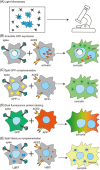Spike protein mediated membrane fusion during SARS-CoV-2 infection
- PMID: 36224449
- PMCID: PMC9874878
- DOI: 10.1002/jmv.28212
Spike protein mediated membrane fusion during SARS-CoV-2 infection
Abstract
The pandemic caused by severe acute respiratory syndrome coronavirus 2 (SARS-CoV-2) has posed a serious threat to public health and has quickly become a global concern. The infection of SARS-CoV-2 begins with the binding of its spike protein to the receptor-angiotensin-converting enzyme 2 (ACE2), which, after a series of conformation changes, results in the fusion of viral-cell membranes and the release of the viral RNA genome into the cytoplasm. In addition, infected host cells can express spike protein on their cell surface, which will interact with ACE2 on neighboring cells, leading to cell membrane fusion and the formation of multinucleated cells or syncytia. Both viral entry and syncytia formation are mediated by spike-ACE2 interaction and share some common mechanisms of membrane fusion. Here in this review, we will summarize our current understanding of spike-mediated membrane fusion, which may shed light on future broad-spectrum antiviral development.
Keywords: antiviral agents; cell fusion; cellular effect; coronavirus; entry inhibitors; virus classification.
© 2022 Wiley Periodicals LLC.
Conflict of interest statement
The authors declare no conflicts of interest.
Figures



Similar articles
-
Potential therapeutic approaches for the early entry of SARS-CoV-2 by interrupting the interaction between the spike protein on SARS-CoV-2 and angiotensin-converting enzyme 2 (ACE2).Biochem Pharmacol. 2021 Oct;192:114724. doi: 10.1016/j.bcp.2021.114724. Epub 2021 Aug 8. Biochem Pharmacol. 2021. PMID: 34371003 Free PMC article. Review.
-
In silico investigation of critical binding pattern in SARS-CoV-2 spike protein with angiotensin-converting enzyme 2.Sci Rep. 2021 Mar 25;11(1):6927. doi: 10.1038/s41598-021-86380-2. Sci Rep. 2021. PMID: 33767306 Free PMC article.
-
The Integral Membrane Protein ZMPSTE24 Protects Cells from SARS-CoV-2 Spike-Mediated Pseudovirus Infection and Syncytia Formation.mBio. 2022 Oct 26;13(5):e0254322. doi: 10.1128/mbio.02543-22. Epub 2022 Oct 5. mBio. 2022. PMID: 36197088 Free PMC article.
-
In Silico, In Vitro and In Cellulo Models for Monitoring SARS-CoV-2 Spike/Human ACE2 Complex, Viral Entry and Cell Fusion.Viruses. 2021 Feb 25;13(3):365. doi: 10.3390/v13030365. Viruses. 2021. PMID: 33669132 Free PMC article.
-
Spike Glycoprotein-Mediated Entry of SARS Coronaviruses.Viruses. 2020 Nov 11;12(11):1289. doi: 10.3390/v12111289. Viruses. 2020. PMID: 33187074 Free PMC article. Review.
Cited by
-
Discovering natural products as potential inhibitors of SARS-CoV-2 spike proteins.Sci Rep. 2025 Jan 2;15(1):200. doi: 10.1038/s41598-024-83637-4. Sci Rep. 2025. PMID: 39747174 Free PMC article.
-
Using Nano-Luciferase Binary (NanoBiT) Technology to Assess the Interaction Between Viral Spike Protein and Angiotensin-Converting Enzyme II by Aptamers.BioTech (Basel). 2025 Mar 15;14(1):20. doi: 10.3390/biotech14010020. BioTech (Basel). 2025. PMID: 40227272 Free PMC article.
-
SARS-CoV-2 infection enhancement by amphotericin B: implications for disease management.J Virol. 2025 Jul 22;99(7):e0051925. doi: 10.1128/jvi.00519-25. Epub 2025 Jun 4. J Virol. 2025. PMID: 40464579 Free PMC article.
-
The impact of S2 mutations on Omicron SARS-CoV-2 cell surface expression and fusogenicity.Emerg Microbes Infect. 2024 Dec;13(1):2297553. doi: 10.1080/22221751.2023.2297553. Epub 2024 Feb 13. Emerg Microbes Infect. 2024. PMID: 38112266 Free PMC article.
-
Research Progress on Spike-Dependent SARS-CoV-2 Fusion Inhibitors and Small Molecules Targeting the S2 Subunit of Spike.Viruses. 2024 Apr 30;16(5):712. doi: 10.3390/v16050712. Viruses. 2024. PMID: 38793593 Free PMC article. Review.
References
Publication types
MeSH terms
Substances
LinkOut - more resources
Full Text Sources
Medical
Miscellaneous

